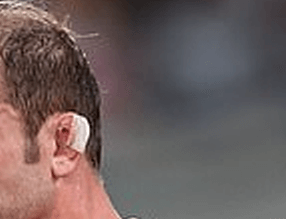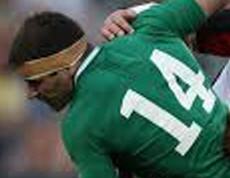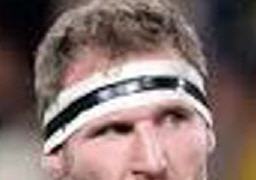You’ll probably see a few rugby players with tape on their ears in every match at senior level. Players usually wear tape to avoid certain types of ear injuries.
If you’re thinking of taking up the game, you may be wondering if you should follow their example. And if so, why and how do rugby players tape their ears?
Read on for reasons, tips, and examples.
Rugby Players Tape Their Ears To Avoid Injuries
There are several types of ear injuries that rugby players would prefer to avoid:
- Nicks and cuts in rucks (player pile-ups)
- Lacerations (usually in the tackle)
- Cauliflower ears from scrums
Different tape and taping methods tend to be used depending on what the player is trying to avoid. Let’s take a look at each avoidance measure.
Taping Ears To Avoid Nicks And Cuts In Rugby
Little nicks and cuts are most likely to happen at the top of your ear or where it joins with the head. This becomes more painful when they’re happening on a weekly basis and not getting time to heal.
The picture shows how one of the modern greats of rugby protects his ears against these nicks and cuts. Alun Wyn Jones, the Welsh lock and captain, uses minimal tape over a quarter of his ear.

Avoiding Ear Lacerations In Rugby
Lacerations are deeper cuts and tears. These are more serious problems but also more rare in rugby. I’m not going to show a gory picture, but I’m referring to rips in the skin that may require stitching.
Getting stuck at the bottom of a ruck can cause little nicks. But even your own players can accidentally rake your ear with their studs, causing a deeper tear.
Ironically, a player making a tackle is more prone to a laceration than the tackled player.

Good tackling technique teaches you where to put your head when tackling, so don’t worry that this is a frequent problem.
It’s more of an occasional freak occurrence. For example, I’ve heard of someone tearing half their ear in a practice session. They were actually launching into a tackle bag!
A bit of ear stitching means a player can return very quickly to a match (unless there’s a head injury). But their ear is now more vulnerable for a while to further collisions. This brings us to another question people ask.
Why Do Rugby Backs Tape Their Ears?
Backs in rugby tend to tape their ears when they are still healing from an ear injury. Some backs who have repeated injuries will wear tape for every match.
I’m showing the jersey number in this picture to prove that it’s a back.

This Irish international winger (Fergus McFadden) didn’t wear tape for many years. He’s had a few injuries through his career, and we saw him first wearing bandaging and tape when he came back from a spell out of the game.
Taping To Avoid Cauliflower Ears In Rugby
Cauliflower ears used to be far more prevalent amongst rugby forwards, but are less common due to some form of ear protection.
Many forwards, especially the front row, will choose to wear scrum caps with flaps that cover the ear. But some players find scrum caps are too hot and choose to wear tape.
This hooded stare belongs to another great lock in world rugby, All Blacks captain Kieran Reid. This hardened Kiwi is old school in his choice of bandage and electrical tape.

Some gnarly old forwards would roll their eyes at the bandaging. Vaseline and tape are good enough! And some of them only wear tape! I’ll look at the different options after a basic tutorial on how to tape your ears.
And my best advice is – don’t listen too closely to the gnarly old forwards!
Tips On Taping Your Ears In Rugby
You can find a few different videos from tape manufacturers that provide demonstrations. There’s no single right way to tape your ears, and you’ll eventually establish your own preferred technique.
There are two key points for successful taping:
- Do not restrict your vision
- Ensure that the tape doesn’t come loose
It’s easy to restrict your side vision with poor positioning of the tape. This will impact your game in lots of ways. Even protecting your ball in a ruck will be more difficult.
To ensure that the tape is secure, you should always bring the tape around the lower section of the back of your head. Otherwise, it will slip upward and get loose.
Now, let’s run through your different options for taping your ears.
Old School – Vaseline And Black Electrical Tape
I was somewhat tongue-in-cheek when I mentioned gnarly old forwards who prefer the simplest solution of insulation tape.
Electrical (or insulation) tape will protect the ears. The problem comes when you’re taking it off! It’s painful where it meets the skin, and this is where vaseline comes into play.
Electrical tape will also tear your hair as you peel it off.
For both these reasons, you can use some form of bandaging under the tape.
Using Pre-wrap Under Tape
Pre-wrap is a very thin form of bandaging that is designed precisely to keep adhesive tape from sticking to your skin.
It’s cheap to buy a bundle of rolls. If you’re trying it out for the first time, I suggest you borrow a roll from a teammate who likes to use them. You can also probably find a spare roll in the medical kit.
You only need a couple of layers of pre-wrap before you cover it with athletic tape and/or electrical tape. Remember that you’re not going for a bandaging effect with pre-wrap, it is purely to stop the tape from hitting your skin and hair.
Check out our best pick of pre-wrap on Amazon.
Using Plain Bandage Under Tape
Some players find that pre-wrap protects bare skin but they still have a problem with hair. Personally, I think they’re not applying the pre-wrap properly. But hey, use whatever works for you.
So, these players start with layers of plain bandage around their ears and head. You’ll need electrical tape to keep this from unraveling.
But even with electrical tape, some players find that the bandaging layer tends to unravel. They need something with more strength and stickiness. They often turn to athletic tape.
Using Athletic Tape Under Tape
Some players wrap athletic tape around their head so that it covers the tops of their ears.
However, adhesive athletic tape won’t be secure enough on its own. You can secure it with a few rounds of electrical tape.
Using All Combinations Of Tape
I checked out the favorite techniques used by a few different players. Here’s some quotes from guys who like to use three types of tape.
I like the rule of twos! Two layers of pre-wrap, two layers of athletic tape, and two layers of insulation tape (electrical tape).
Start with pre-wrap, cover with two swoops of athletic tape, and enough swoops of electric tape to keep everything secure.
This may seem a lot of work, but it quickly becomes part of your pre-match ritual.
Other Uses For Tape
You’ll find lots of uses for those rolls of tape in your sports bag.
Check out our article on how and why rugby players tape their thighs.
And we have another article on why rugby players tape their wrists.
Rugby Quiz!
Think you know your rugby?
Let's see if you can match the quote to the player or coach!
Here are seven quotes. How well will you do?
